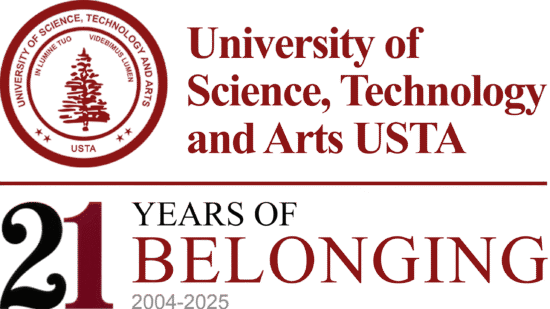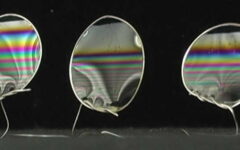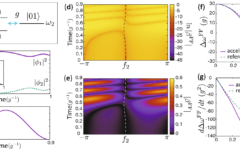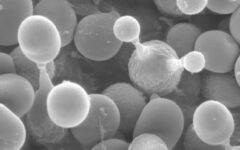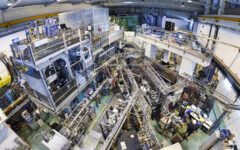Scientists tie the tightest knot ever achieved
7 August 2023 2023-08-07 19:11Scientists tie the tightest knot ever achieved

Scientists tie the tightest knot ever achieved
Source: University of Manchester
Summary: Scientists have produced the most tightly knotted physical structure ever known — a scientific achievement which has the potential to create a new generation of advanced materials.
Scientists at The University of Manchester have produced the most tightly knotted physical structure ever known — a scientific achievement which has the potential to create a new generation of advanced materials.
The University of Manchester researchers, led by Professor David Leigh in Manchester’s School of Chemistry, have developed a way of braiding multiple molecular strands enabling tighter and more complex knots to be made than has previously been possible.
The breakthrough knot has eight crossings in a 192-atom closed loop — which is about 20 nanometres long (ie 20 millionths of a millimeter).
Being able to make different types of molecular knots means that scientists should be able to probe how knotting affects strength and elasticity of materials which will enable them to weave polymer strands to generate new types of materials.
Professor David Leigh said: “Tying knots is a similar process to weaving so the techniques being developed to tie knots in molecules should also be applicable to the weaving of molecular strands.
“For example, bullet-proof vests and body armour are made of kevlar, a plastic that consists of rigid molecular rods aligned in a parallel structure — however, interweaving polymer strands have the potential to create much tougher, lighter and more flexible materials in the same way that weaving threads does in our everyday world.
“Some polymers, such as spider silk, can be twice as strong as steel so braiding polymer strands may lead to new generations of light, super-strong and flexible materials for fabrication and construction.”
Professor David Leigh said he and his team were delighted to have achieved this scientific landmark.
He explained the process behind their success: “We ‘tied’ the molecular knot using a technique called ‘self-assembly’, in which molecular strands are woven around metal ions, forming crossing points in the right places just like in knitting — and the ends of the strands were then fused together by a chemical catalyst to close the loop and form the complete knot.
“The eight-crossings molecular knot is the most complex regular woven molecule yet made by scientists.”
Related Posts
Synchrotron sheds (X-ray) light on carbon chemistry at ocean surfaces
Physics of bubbles could explain language patterns
Frequency modulation accelerates the research of quantum technologies
Fungal spores harness physics to launch themselves
Physics: Toward a practical nuclear pendulum
Search
Categories
- Acoustics (1)
- Admission (14)
- Alumni (19)
- Bacteria (1)
- Behavioral Science (1)
- Biochemistry (1)
- Biochemistry Research (1)
- Biology (1)
- Biotechnology (1)
- Blog (10)
- Botany (1)
- Career (14)
- Cell Biology (1)
- Chemistry (1)
- Chemistry (1)
- Developmental Biology (1)
- Epigenetics Research (1)
- Evolutionary Biology (1)
- Fungus (1)
- Fungus (1)
- Genetics (1)
- Health (1)
- Inorganic Chemistry (1)
- Life Sciences (1)
- Marine Biology (1)
- Mating and Breeding (1)
- Microbes and More (1)
- Microbiology (1)
- Molecular Biology (1)
- Nature of Water (1)
- News (39)
- Optics (1)
- Organic Chemistry (1)
- Physics (1)
- Prions (1)
- Prions (1)
- Quantum Computing (1)
- Quantum Physics (1)
- Research (38)
- Spotlight (15)
- Student life (15)
- Student story (13)
- Technology (1)
- Thermodynamics (1)
- Ultrasound (1)
- Uncategorized (10)
- Virology (1)
- Zika Virus Research (1)
- Zoology (1)
Get the latest University of Science, Technology and Arts news
Carborane-Cluster-Wrapped Copper Cluster with Cyclodextrin-like Cavities for Chiral Recognition | Journal of the American Chemical Society #Carborane #Cluster #Cu #Cyclodextrin #Chiral #Recognition
This week in #LCSOSynthesisProblem @DuncanBrownsey challenged us with the total synthesis of Wickerol A and B by Gui and coworkers @Jinghan_Gui in @J_A_C_S. #TotalSynthesis #Chemistry
Take a look: https://www.epfl.ch/labs/lcso/wp-content/uploads/2024/06/Wickerol-A-Gui-2020.pdf
Original paper: https://pubs.acs.org/doi/10.1021/jacs.9b11838
Modified Halloysite as Catalyst for the Conversion of Hydroxymethylfurfural to Furandicarboxylic Acid: A DFT Investigation (Dario Duca and co-workers)
Topological electride of 𝑡-YCl, Yiwei Liang, Xinyan Lin, Biao Wan, Zhaopeng Guo, Xuyan Cao, Dexi Shao, Jian Sun, and Huiyang Gou #CondensedMatter #ChemicalPhysics https://go.aps.org/3VwcMZ5
G-Quadruplex mRNAs Silencing with Inducible Ribonuclease Targeting Chimera for Precision Tumor Therapy | Journal of the American Chemical Society #Quadruplex #mRNA #Silencing #Ribonuclease #Chimera #Tumor #Therapy
Polycationic Open‐Shell Cyclophanes: Synthesis of Electron‐Rich Chiral Macrocycles, and Redox‐Dependent Electronic States – Shi – Angewandte Chemie International Edition – Wiley Online Library
Perspective on the Development of Monomer Recovery Technologies from Plastics Designed to Last
A Perspective by Steffan K. Kristensen, Troels Skrydstrup et al. @AarhusUni_int
🔓 Open access in ACS Organic & Inorganic Au 👉 https://go.acs.org/9Gv
A fantastic collection of activities to provoke and deepen mathematical thinking. ‘Thinkers’ will enhance the teaching and learning of mathematics for new and experienced teachers, and for learners from 8 to 18 (and beyond). http://bit.ly/ATMthinkers.
ICYMI, from our Emerging Investigators collection 🎉
‘Gold-catalyzed benzannulations of 2-alkenylindoles with alkynes: a protecting-group-free regioselective approach to carbazoles’ by Youliang Wang at Xi’an Jiaotong University.
Catalyst-Free α-trans-Selective Hydroboration and (E)-Selective Deuterated Semihydrogenation of Alkynyl Sulfones (@JOC_OL): https://pubs.acs.org/doi/10.1021/acs.joc.3c02833.
https://www.organic-chemistry.org/abstracts/lit3/936.shtm
A simple continuous hydrogenation of alkenes and alkynes with in situ generated diimide
Molecular Triplet Generation Enabled by Adjacent Metal Nanoparticles | Journal of the American Chemical Society #Triplet #Generation #Metal #Nanoparticles
Photonic implementation of the quantum Morra game, Andrés Ulibarrena, Alejandro Sopena, Russell Brooks, Daniel Centeno, Joseph Ho, Germán Sierra, and Alessandro Fedrizzi #Quantum #QuantumInformation https://go.aps.org/45eWCru
We’re excited to share our latest preprint on @ChemRxiv! The talented @Zhipengluu developed a new photo-active hypervalent iodine reagent for the diversification of aliphatic C–H bonds. Check it out: https://chemrxiv.org/engage/chemrxiv/article-details/665755b321291e5d1d8dfdbf
Now in @InorgChem! Read the article featuring pyrazine (pz)-bridged dinuclear Ru2(II,II) and Ru2(III,III) complexes and pz-containing mononuclear Ru(II) and Ru(III) complexes, which were afforded through the reactions of the (μ-Cl)3 Ru(II,II) complex: https://go.acs.org/9Gq
Long-Range Gating in Single-Molecule One-Dimensional Topological Insulators | Journal of the American Chemical Society @ColumbiaScience @Columbia @ChemColumbia @APAMMSECU #Gating #Topological #Insulators
Diastereo- and Enantioselective Construction of Stereochemical Arrays Exploiting Non-Classical Hydrogen Bonding in Enolborates (@ChemEurJ): https://chemistry-europe.onlinelibrary.wiley.com/doi/10.1002/chem.202401485.
A Review on the Recent Advances in Developing Radical Methods for the Synthesis of Aliphatic Sulfonyl Fluorides by Zhong-Yan Cao, Saihu Liao, and co-workers
